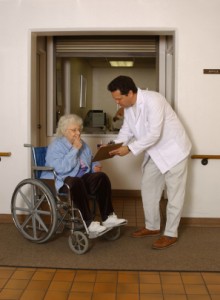
Guess what Grandma? You’re moving!
They are the forgotten. They are the indigent by virtual of having to qualify for a government program by spending down all their assets. They are the frail and sick, utterly dependent on the largess of the government. They are the thousands of residents at skilled nursing facilities whose monthly board and care is paid for through Medi-Cal. Now they are being threatened by California Department of Health Care Services reducing payments and “clawing back” payments through 2011.
No patient advocates
Many states have to grapple with cuts and changes to Medicaid appropriations passed by Congress in 2010. It is no exaggeration to compare those on Medicaid in skilled nursing facilities with the vulnerability of new born baby or toddler. In the best of situations, they have a trusted friend or family member visit them a couple times a month. The vast majority have no patient advocate to ask about care and medical questions on their behalf.
Long term crisis looming with aging baby-boomers
There are over 870,000 Medicaid residents in long term care in over 15,000 assisted and skilled nursing facilities across the U.S. For better or worse, their bodies have out lived their savings or chronic medical issues have robbed them of their ability to work and care for themselves. They resign themselves to the reality that they must live three to a room with people they have never met before. Some are grateful, others are bitter and then there are those who have lost the wonder of the day due to dementia or Alzheimer’s.
California Medi-Cal spending on LTC is huge
California in 2010 had 101,854 nursing facility residents, 68% on Medi-Cal, in 1,229 facilities. For 2010, the most recent statistics from Kaiser Family Foundation State Health Facts website, California spent $42.1 billion on Medicaid programs. 33% of that spending went to nursing facilities or approximately $13.8 billion. California received a 61.59% matching reimbursement from federal Medicaid in 2010. Those matching funds dropped to 50% for fiscal years 2012 and 2013, which is the minimum floor of reimbursement. There was a temporary increase in the percentage of matching funds in 2009 and 2010 which accounted for California’s spike in federal Medicaid funds. After losing court battles, opponents of the Medi-Cal cuts to long term care facilities face the grim prospect of reduced service or closing their doors altogether.
Complicated Medicaid formulas
Medicaid works under a formula where the federal government will pay a minimum of 50% of the states program costs for individuals receiving Medicaid benefits. There are numerous formulas, waivers, income levels, benefits and eligibility factors to consider for each state. Even with the best of juggling, states come up short . In California, their Medicaid program, Medi-Cal, is looking at drastically reducing benefits retroactively back to 2011 to make up for matching Medicaid funds they never received.
Rural facilities hit hardest
Hit hardest will be rural skilled nursing facilities that rely heavily on Medicaid reimbursement to keep the doors open. Eastern Plumas Health Care, a rural healthcare provider, is estimating losing $2.4 million this year alone if the proposed cuts go through. Like many of rural facilities, they are not sure their skilled nursing facilities even have a future with the cuts to Medi-Cal reimbursement rates.
Where will the money come from?
Even if California legislators are successful in stopping the reduction and retro-active withholding of past payments to skilled nursing facilities for residents on Medi-Cal with AB 900, the money will have to come from some place. This would be a good time for Governor Brown to roll up his sleeves and find a solution so we don’t forsake California’s most vulnerable citizens.
Forgotten, but not a spending problem
It is easy to sit in a chair on a Sunday morning news show and pound the table that the U.S. has a spending problem. I am not sure how many Medicaid patients sit in their nursing beds feel they are a spending problem. How we treat our elderly is a vital measuring stick of how good we are as a nation. They may be forgotten, tucked in little nursing homes throughout our communities, but the poorest and oldest of our citizens are not a spending problem.

